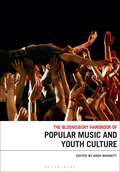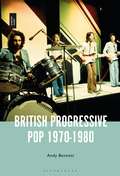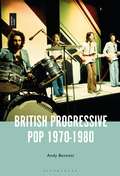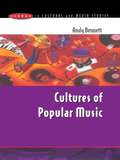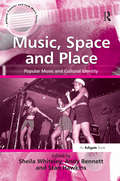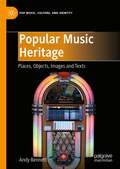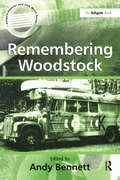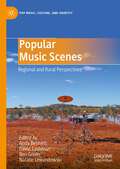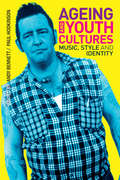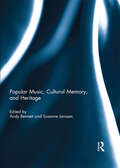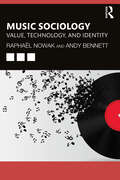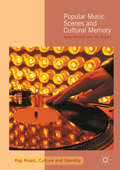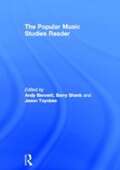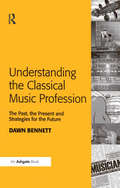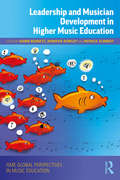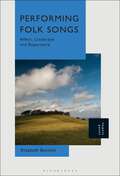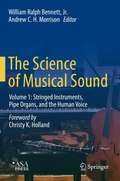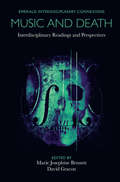- Table View
- List View
The Bloomsbury Handbook of Popular Music and Youth Culture (Bloomsbury Handbooks)
by Andy BennettThe Bloomsbury Handbook of Popular Music and Youth Culture provides a comprehensive and fully up-to-date overview of key themes and debates relating to the academic study of popular music and youth culture. While this is a highly popular and rapidly expanding field of research, there currently exists no single-source reference book for those interested in this topic. The handbook is comprised of 32 original chapters written by leading authors in the field of popular music and youth culture and covers a range of topics including: theory; method; historical perspectives; genre; audience; media; globalization; ageing and generation.
British Progressive Pop 1970-1980
by Andy BennettPositioned between the psychedelic and counter-cultural music of the late 1960s and the punk and new wave styles of the late 1970s, early 1970s British popular music is often overlooked in pop music studies of the late 20th century, but it was, in fact, highly diverse with many artists displaying an eclecticism and flair for musical experimentation. 'Progressive pop' artists such as Roxy Music, David Bowie, the early Queen, the Electric Light Orchestra, 10cc and Steve Harley & Cockney Rebel successfully straddled the album and singles markets, producing music that often drew on a variety of different musical styles and traditions. Similarly, such artists often set new benchmarks for songwriting and production, utilizing the full potential of the rapidly expanding studio technology of the era to produce albums of highly diverse material featuring, in some cases, special studio-crafted effects and soundscapes that remain unique to this day. This book considers the significance of British progressive pop in the early 1970s as a period during which the boundaries between pop and rock were periodically relaxed, providing a platform for musical creativity less confined by genre and branding.
British Progressive Pop 1970-1980
by Andy BennettPositioned between the psychedelic and counter-cultural music of the late 1960s and the punk and new wave styles of the late 1970s, early 1970s British popular music is often overlooked in pop music studies of the late 20th century, but it was, in fact, highly diverse with many artists displaying an eclecticism and flair for musical experimentation. 'Progressive pop' artists such as Roxy Music, David Bowie, the early Queen, the Electric Light Orchestra, 10cc and Steve Harley & Cockney Rebel successfully straddled the album and singles markets, producing music that often drew on a variety of different musical styles and traditions. Similarly, such artists often set new benchmarks for songwriting and production, utilizing the full potential of the rapidly expanding studio technology of the era to produce albums of highly diverse material featuring, in some cases, special studio-crafted effects and soundscapes that remain unique to this day. This book considers the significance of British progressive pop in the early 1970s as a period during which the boundaries between pop and rock were periodically relaxed, providing a platform for musical creativity less confined by genre and branding.
Cultures of Popular Music (UK Higher Education OUP Humanities & Social Sciences Media, Film & Cultural Studies)
by Andy Bennett* What is the relationship between youth culture and popular music?* How have they evolved since the second world war?* What can we learn from a global perspective?In this lively and accessible text, Andy Bennett presents a comprehensive cultural, social and historical overview of post-war popular music genres, from rock 'n' roll and psychedelic pop, through punk and heavy metal, to rap, rave and techno. Providing a chapter by chapter account, Bennett also examines the style-based youth cultures to which such genres have given rise. Drawing on key research in sociology, media studies and cultural studies, the book considers the cultural significance of respective post-war popular music genres for young audiences, with reference to issues such as space and place, ethnicity, gender, creativity, education and leisure. A key feature of the book is its departure from conventional Anglo-American perspectives. In addition to British and US examples, the book refers to studies conducted in Germany, Holland, Sweden, Israel, Australia, New Zealand, Mexico, Japan, Russia and Hungary, presenting the cultural relationship between youth culture and popular music as a truly global phenomenon.
Music, Space and Place: Popular Music and Cultural Identity
by Andy BennettMusic, Space and Place examines the urban and rural spaces in which music is experienced, produced and consumed. The editors of this collection have brought together new and exciting perspectives by international researchers and scholars working in the field of popular music studies. Underpinning all of the contributions is the recognition that musical processes take place within a particular space and place, where these processes are shaped both by specific musical practices and by the pressures and dynamics of political and economic circumstances. Important discourses are explored concerning national culture and identity, as well as how identity is constructed through the exchanges that occur between displaced peoples of the world's many diasporas. Music helps to articulate a shared sense of community among these dispersed people, carving out spaces of freedom which are integral to personal and group consciousness. A specific focal point is the rap and hip hop music that has contributed towards a particular sense of identity as indigenous resistance vernaculars for otherwise socially marginalized minorities in Cuba, France, Italy, New Zealand and South Africa. New research is also presented on the authorial presence in production within the domain of the commercially driven Anglo-American music industry. The issue of authorship and creativity is tackled alongside matters relating to the production of musical texts themselves, and demonstrates the gender politics in pop. Underlying Music, Space and Place, is the question of how the disciplines informing popular music studies - sociology, musicology, cultural studies, media studies and feminism - have developed within a changing intellectual climate. The book therefore covers a wide range of subject matter in relation to space and place, including community and identity, gender, race, 'vernaculars', power, performance and production.
Music, Space and Place: Popular Music and Cultural Identity (Ashgate Popular And Folk Music Ser.)
by Andy BennettMusic, Space and Place examines the urban and rural spaces in which music is experienced, produced and consumed. The editors of this collection have brought together new and exciting perspectives by international researchers and scholars working in the field of popular music studies. Underpinning all of the contributions is the recognition that musical processes take place within a particular space and place, where these processes are shaped both by specific musical practices and by the pressures and dynamics of political and economic circumstances. Important discourses are explored concerning national culture and identity, as well as how identity is constructed through the exchanges that occur between displaced peoples of the world's many diasporas. Music helps to articulate a shared sense of community among these dispersed people, carving out spaces of freedom which are integral to personal and group consciousness. A specific focal point is the rap and hip hop music that has contributed towards a particular sense of identity as indigenous resistance vernaculars for otherwise socially marginalized minorities in Cuba, France, Italy, New Zealand and South Africa. New research is also presented on the authorial presence in production within the domain of the commercially driven Anglo-American music industry. The issue of authorship and creativity is tackled alongside matters relating to the production of musical texts themselves, and demonstrates the gender politics in pop. Underlying Music, Space and Place, is the question of how the disciplines informing popular music studies - sociology, musicology, cultural studies, media studies and feminism - have developed within a changing intellectual climate. The book therefore covers a wide range of subject matter in relation to space and place, including community and identity, gender, race, 'vernaculars', power, performance and production.
Popular Music Heritage: Places, Objects, Images and Texts (Pop Music, Culture and Identity)
by Andy BennettThis book critically discusses the significance of popular music heritage as a means of remembering and re-presenting rock and pop artists, their music and their place in the culture of contemporary society. Since the mid-1990s, the contribution of popular music to the shaping of contemporary history and heritage has increasingly been acknowledged. In the same period, exhibitions of popular music related artefacts have become more commonplace in museums, and facilities dedicated to the celebration of popular music history and heritage, such as the Rock and Roll Hall of Fame, have opened their doors. Popular music heritage has found other mediums of expression too. There is now a significant popular music heritage media, including books, magazines, films and television series. Fans collect and display their own mementos, while the live performances of tribute bands and classic albums fulfill an increasing desire for the live spectacle of popular music heritage. This book will be crucial reading for established scholars as well as postgraduate and undergraduate students studying popular music heritage.
Remembering Woodstock (Ashgate Popular and Folk Music Series)
by Andy BennettThe Woodstock festival of 1969, which featured such groups and artists as the Who, Country Joe and the Fish, Ten Years After, Janis Joplin and Jimi Hendrix, is remembered as much for its 'bringing together' of the counter-cultural generation as for the music performed. The event represented a milestone in the use of music as a medium for political expression while simultaneously acting as a springboard for the more expressly commercial of rock and pop events which were to follow. In the thirty years since the festival took place, Woodstock has become the subject of many books, magazine articles and documentaries which have served to mythologise the event in the public imagination. These different aspects of the Woodstock festival will be discussed in this wide ranging book which brings together a number of established and new writers in the fields of sociology, media studies and popular music studies. Each of the five chapters which will focus on a specific aspect of the Woodstock festival and its continuing significance in relation to the music industry, the rock festival 'tradition', sixties nostalgia and the cultural impact of popular music.
Remembering Woodstock (Ashgate Popular and Folk Music Series)
by Andy BennettThe Woodstock festival of 1969, which featured such groups and artists as the Who, Country Joe and the Fish, Ten Years After, Janis Joplin and Jimi Hendrix, is remembered as much for its 'bringing together' of the counter-cultural generation as for the music performed. The event represented a milestone in the use of music as a medium for political expression while simultaneously acting as a springboard for the more expressly commercial of rock and pop events which were to follow. In the thirty years since the festival took place, Woodstock has become the subject of many books, magazine articles and documentaries which have served to mythologise the event in the public imagination. These different aspects of the Woodstock festival will be discussed in this wide ranging book which brings together a number of established and new writers in the fields of sociology, media studies and popular music studies. Each of the five chapters which will focus on a specific aspect of the Woodstock festival and its continuing significance in relation to the music industry, the rock festival 'tradition', sixties nostalgia and the cultural impact of popular music.
Popular Music Scenes: Regional and Rural Perspectives (Pop Music, Culture and Identity)
by Andy Bennett David Cashman Ben Green Natalie LewandowskiThis book examines regional and rural popular music scenes in Europe, Asia, North America and Australia. The book is divided into four parts. Part 1 will focus on the spatial aspects of regional popular music scenes and how place and locality inform the perceptions and discourses of those involved in such scenes. Part 2 focuses on the technologies and forms of distribution whereby regional and rural popular music scenes exist and, in many cases co-exist in forms of trans-local connection with other scenes. Part 3 considers the importance of collective memory in the way that regional and rural popular music scenes are constructed in both the past and the present. Part 4 examines themes of industry and policy, in relation to culture and music, as these impact on the nature and identity of rural and regional popular music scenes.
Ageing and Youth Cultures: Music, Style and Identity
by Andy Bennett Paul HodkinsonWhat happens to punks, clubbers, goths, riot grrls, soulies, break-dancers and queer scene participants as they become older? For decades, research on spectacular 'youth cultures' has understood such groups as adolescent phenomena and assumed that involvement ceases with the onset of adulthood. In an age of increasingly complex life trajectories, Ageing and Youth Cultures is the first anthology to challenge such thinking by examining the lives of those who continue to participate into adulthood and middle-age. Showcasing a range of original research case studies from across the globe, the chapters explore how participants reconcile their continuing involvement with ageing bodies, older identities and adult responsibilities. Breaking new ground and establishing a new field of study, the book will be essential reading for students and scholars researching or studying questions of youth, fashion, popular music and identity across a wide range of disciplines.
Popular Music, Cultural Memory, and Heritage
by Andy Bennett Susanne JanssenPopular music is increasingly being represented and celebrated as an aspect of contemporary cultural history and heritage. In many places across the world, popular music heritage sites – including museums, archives, commemorative plaques adorning buildings, and what could be referred to as DIY music heritage initiatives – constitute some of the key ways in which popular music artists, scenes and events are being remembered. Bringing together a selection of wide-ranging contributions, the purpose of this book is to present a number of case studies from Europe and Australia that demonstrate the variety of ways in which popular music is being cast as cultural heritage and as a medium that invokes the collective memory of successive generations whose identity and sense of cultural belonging have often been indelibly inscribed by the musical soundscapes of their teen and early adult years. This book was originally published as a special issue of Popular Music and Society.
Music Sociology: Value, Technology, and Identity
by Andy Bennett Raphaël NowakMusic Sociology critically evaluates current approaches to the study of music in sociology and presents a broad overview of how music is positioned and represented in existing sociological scholarship. It then goes on to offer a new framework for approaching the sociology of music, taking music itself as a starting point, and considering what music sociology can learn from related disciplines such as critical musicology, ethnomusicology, and cultural studies. As a central form of leisure, consumption, and cultural production, music has attracted significant attention from sociologists who seek to understand its deeper socio-cultural meaning. With case studies that address sound environments, consumption, media technologies, local scenes, music heritage, and ageing, the authors highlight the distinctive nature of musical experience, and show how sociology can illuminate it. Providing both a survey of existing perspectives the sociology of music, and a thought-provoking discussion of how the field can move forward, this concise and accessible book will be a vital reading for anyone teaching or studying music from a sociological standpoint.
Music Sociology: Value, Technology, and Identity
by Andy Bennett Raphaël NowakMusic Sociology critically evaluates current approaches to the study of music in sociology and presents a broad overview of how music is positioned and represented in existing sociological scholarship. It then goes on to offer a new framework for approaching the sociology of music, taking music itself as a starting point, and considering what music sociology can learn from related disciplines such as critical musicology, ethnomusicology, and cultural studies. As a central form of leisure, consumption, and cultural production, music has attracted significant attention from sociologists who seek to understand its deeper socio-cultural meaning. With case studies that address sound environments, consumption, media technologies, local scenes, music heritage, and ageing, the authors highlight the distinctive nature of musical experience, and show how sociology can illuminate it. Providing both a survey of existing perspectives the sociology of music, and a thought-provoking discussion of how the field can move forward, this concise and accessible book will be a vital reading for anyone teaching or studying music from a sociological standpoint.
Popular Music Scenes and Cultural Memory (Pop Music, Culture and Identity)
by Andy Bennett Ian RogersThis volume explores the ways in which music scenes are not merely physical spaces for the practice of collective musical life but are also inscribed with and enacted through the articulation of cultural memory and emotional geography. The book draws on empirical data collected in cites throughout Australia. In terms of understanding the relationship between music scenes and participants, much of the existing popular music literature tends to avoid one key aspect of scene: its predominant past-tense and memory-based nature. Nascent music scenes may be emergent and on-going but their articulation in the present is often based on past events, ideas and histories. There is a noticeable gap between the literature concerning popular music ethnography and the growing body of work on cultural memory and emotional geography. This book is a study of the conceptual formation and use of music scenes by participants. It is also an investigation of the structures underpinning music scenes more generally.
The Popular Music Studies Reader
by Andy Bennett Barry Shank Jason ToynbeeThe Popular Music Studies Reader maps the changing nature of popular music over the last decade and considers how popular music studies has expanded and developed to deal with these changes. A wide range of international contributors featuring some of the biggest names in popular music and cultural studies including Philip Auslander, Paul Gilroy and Kodwo Eshun and discuss: * the increasing participation of women in the industry * the changing role of gender and sexuality in popular music * the role of new technologies, especially in production and distribution * the changing nature of the relationship between music production and consumption. The Popular Music Studies Reader places popular music in its cultural context, looks at the significance of popular music in our everyday lives, and examines the global nature of the music industry.
Understanding the Classical Music Profession: The Past, the Present and Strategies for the Future
by Dawn Elizabeth BennettUnderstanding the Classical Music Profession is an essential resource for educators, practitioners and researchers who seek to understand the careers of classically-trained musicians, and the extent to which professional practice is reflected within existing classical performance-based music education and training. Taking Australia as a case-study, Dawn Bennett outlines how Australia is now a service economy, and an important component of service provision is in the culture and recreation industries. Despite this, employment in culture and recreation is poorly understood and a lack of cultural intelligence contributes to a less than satisfactory environment that inhibits the creative potential of cultural practitioners. Musicians in the twenty-first century require a broad and evolving base of skills and knowledge to sustain their careers as cultural practitioners. Bennett maintains that a musician cannot be simply defined as a performer, but that a musician is someone who works within the profession of music in one or more specialist fields. The perception of a musician as a multi-skilled professional working within a portfolio career has significant implications for policy, funding, education and training, and for practitioners and students seeking to achieve sustainable careers. This indispensable book provides a comprehensive analysis of life as a musician, from education and training to professional practice as well as revealing the structure of the Australian cultural industries. Although Australia is the focus of the book, the basis of the research originates from many different places and most of the issues discussed relate directly to other countries throughout the world.
Understanding the Classical Music Profession: The Past, the Present and Strategies for the Future
by Dawn Elizabeth BennettUnderstanding the Classical Music Profession is an essential resource for educators, practitioners and researchers who seek to understand the careers of classically-trained musicians, and the extent to which professional practice is reflected within existing classical performance-based music education and training. Taking Australia as a case-study, Dawn Bennett outlines how Australia is now a service economy, and an important component of service provision is in the culture and recreation industries. Despite this, employment in culture and recreation is poorly understood and a lack of cultural intelligence contributes to a less than satisfactory environment that inhibits the creative potential of cultural practitioners. Musicians in the twenty-first century require a broad and evolving base of skills and knowledge to sustain their careers as cultural practitioners. Bennett maintains that a musician cannot be simply defined as a performer, but that a musician is someone who works within the profession of music in one or more specialist fields. The perception of a musician as a multi-skilled professional working within a portfolio career has significant implications for policy, funding, education and training, and for practitioners and students seeking to achieve sustainable careers. This indispensable book provides a comprehensive analysis of life as a musician, from education and training to professional practice as well as revealing the structure of the Australian cultural industries. Although Australia is the focus of the book, the basis of the research originates from many different places and most of the issues discussed relate directly to other countries throughout the world.
Leadership and Musician Development in Higher Music Education (ISME Global Perspectives in Music Education Series)
by Dawn Bennett Jennifer Rowley Patrick SchmidtLeadership and Musician Development in Higher Music Education informs, challenges and evaluates the central practices, policies and theories that underpin the preparation of future music leaders and the leadership of music in higher education. In higher education, it is often presumed that preparing for professional work is the responsibility of the individual rather than the institution. This anthology draws on the expertise of music practitioners to present the complexities surrounding this topic, exploring approaches to leadership development while addressing prevalent leadership issues from multiple standpoints. Leadership is an inherent part of being a musician: from the creative act through to collaborative engagement, it is fundamental to creating and sustaining a career in music. To expect musicians to develop these necessary skills "on the job", however, is unreasonable and impractical. What support might be given to those looking to negotiate a career as a musician? In fourteen essays, contributors from around the globe explore this question and more, questions such as: How might leadership be modelled for aspiring musicians? How might students learn to recognise, appraise and extend their leadership development? How might institutional leaders challenge curricular and pedagogical norms? Effective leadership development for musicians is vital to the longevity of the profession – Leadership and Musician Development in Higher Music Education is a likewise vital resource for students, educators and future music leaders alike.
Leadership and Musician Development in Higher Music Education (ISME Global Perspectives in Music Education Series)
by Dawn Bennett Jennifer Rowley Patrick SchmidtLeadership and Musician Development in Higher Music Education informs, challenges and evaluates the central practices, policies and theories that underpin the preparation of future music leaders and the leadership of music in higher education. In higher education, it is often presumed that preparing for professional work is the responsibility of the individual rather than the institution. This anthology draws on the expertise of music practitioners to present the complexities surrounding this topic, exploring approaches to leadership development while addressing prevalent leadership issues from multiple standpoints. Leadership is an inherent part of being a musician: from the creative act through to collaborative engagement, it is fundamental to creating and sustaining a career in music. To expect musicians to develop these necessary skills "on the job", however, is unreasonable and impractical. What support might be given to those looking to negotiate a career as a musician? In fourteen essays, contributors from around the globe explore this question and more, questions such as: How might leadership be modelled for aspiring musicians? How might students learn to recognise, appraise and extend their leadership development? How might institutional leaders challenge curricular and pedagogical norms? Effective leadership development for musicians is vital to the longevity of the profession – Leadership and Musician Development in Higher Music Education is a likewise vital resource for students, educators and future music leaders alike.
Performing Folk Songs: Affect, Landscape and Repertoire
by Dr. Elizabeth BennettPerforming Folk Songs is the first full-length volume to explore English folk singing from the perspective of performance studies. Using archival sources, family repertoire and recorded performances of interviewees, this book argues that archives and repertoires are produced in sensory environments and through embodied encounters. Autoethnography, sensory ethnography, life-writing and landscape writing are used to explore the affective and emotional aspects of learning songs 'by heart'. Drawing on her experience as a folk singer, Bennett contributes to discourse on English folk traditions in the 21st century and brings performance scholarship to the contemporary folk song resurgence. In analyzing the performance of English folk songs in the affective context of the archive and the landscape, the book engages with and contributes original insights to scholarship on folk music, performance studies, affect theory, cultural geography and intangible cultural heritage studies.
Performing Folk Songs: Affect, Landscape and Repertoire
by Dr. Elizabeth BennettPerforming Folk Songs is the first full-length volume to explore English folk singing from the perspective of performance studies. Using archival sources, family repertoire and recorded performances of interviewees, this book argues that archives and repertoires are produced in sensory environments and through embodied encounters. Autoethnography, sensory ethnography, life-writing and landscape writing are used to explore the affective and emotional aspects of learning songs 'by heart'. Drawing on her experience as a folk singer, Bennett contributes to discourse on English folk traditions in the 21st century and brings performance scholarship to the contemporary folk song resurgence. In analyzing the performance of English folk songs in the affective context of the archive and the landscape, the book engages with and contributes original insights to scholarship on folk music, performance studies, affect theory, cultural geography and intangible cultural heritage studies.
The Science of Musical Sound: Volume 1: Stringed Instruments, Pipe Organs, and the Human Voice
by William Ralph Bennett Jr.This textbook is a product of William Bennett’s work in developing and teaching a course on the physics of music at Yale University to a diverse audience of musicians and science students in the same class. The book is a culmination of over a decade of teaching the course and weaves together historical descriptions of the physical phenomena with the author’s clear interpretations of the most important aspects of the science of music and musical instruments. Many of the historical examples are not found in any other textbook available on the market. As the co-inventor of the Helium-Neon laser, Prof. Bennett’s knowledge of physics was world-class. As a professor at one of the most prestigious liberal-arts universities in the world, his appreciation for culture and humanities shines through. The book covers the basics of oscillations, waves and the analysis techniques necessary for understanding how musical instruments work. All types of stringed instruments, pipe organs, and the human voice are covered in this volume. A second volume covers the remaining families of musical instruments as well as selected other topics. Readers without a background in acoustics will enjoy learning the physics of the Science of Musical Sound from a preeminent scientist of the 20th century. Those well versed in acoustics will discover wonderful illustrations and photographs depicting familiar concepts in new and enlightening ways.
Music and Death: Interdisciplinary Readings and Perspectives (Emerald Interdisciplinary Connexions)
by Marie Josephine Bennett David GraconMusic is often our companion when dealing with the incomprehensibility of loss, and yet death and dying are topics that are rarely discussed or analysed in the academic space, especially in combination with music studies. This edited collection examines several ways in which diverse music cultures and societies imagine, express and provide a means of coping with death, grief and remembrance. Written from a variety of interdisciplinary perspectives, including both personal essays and academic studies, the nine chapters are divided into three subsections focusing respectively on mourning, underground scenes, and performance. The authors speak to the multifarious and complex ways in which music accompanies, supplements, and complements aspects of death and dying, whether this is the death of a loved one, or a celebrity from popular culture. The book cuts across disciplines such as musicology, death studies, funeral studies, cultural studies, media studies, celebrity studies, sociology, anthropology and theology, and includes perspectives from Australia, the Netherlands, Poland, Portugal, the United Kingdom and the United States.
Music and Death: Interdisciplinary Readings and Perspectives (Emerald Interdisciplinary Connexions)
by Marie Josephine Bennett David GraconMusic is often our companion when dealing with the incomprehensibility of loss, and yet death and dying are topics that are rarely discussed or analysed in the academic space, especially in combination with music studies. This edited collection examines several ways in which diverse music cultures and societies imagine, express and provide a means of coping with death, grief and remembrance. Written from a variety of interdisciplinary perspectives, including both personal essays and academic studies, the nine chapters are divided into three subsections focusing respectively on mourning, underground scenes, and performance. The authors speak to the multifarious and complex ways in which music accompanies, supplements, and complements aspects of death and dying, whether this is the death of a loved one, or a celebrity from popular culture. The book cuts across disciplines such as musicology, death studies, funeral studies, cultural studies, media studies, celebrity studies, sociology, anthropology and theology, and includes perspectives from Australia, the Netherlands, Poland, Portugal, the United Kingdom and the United States.
